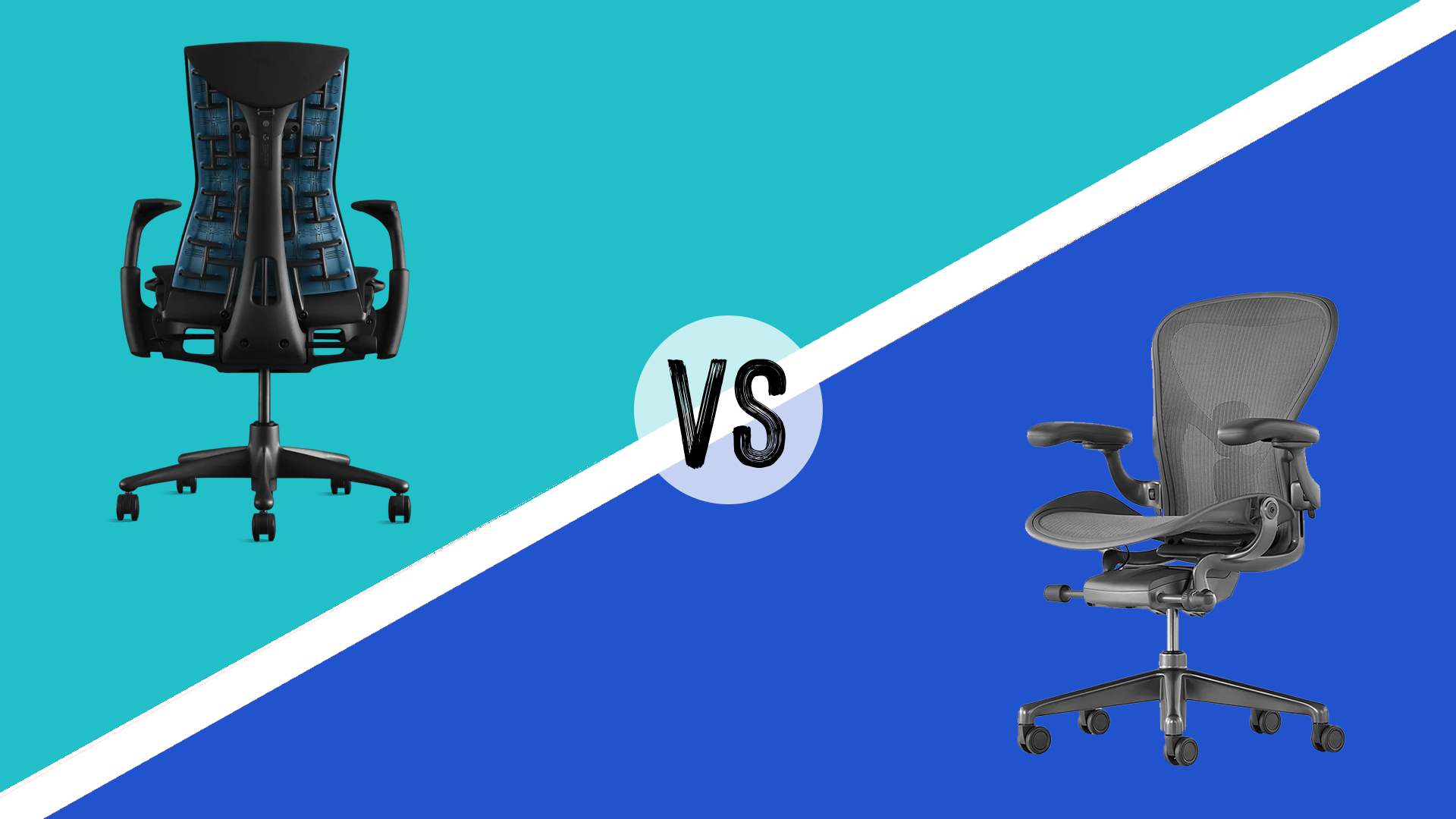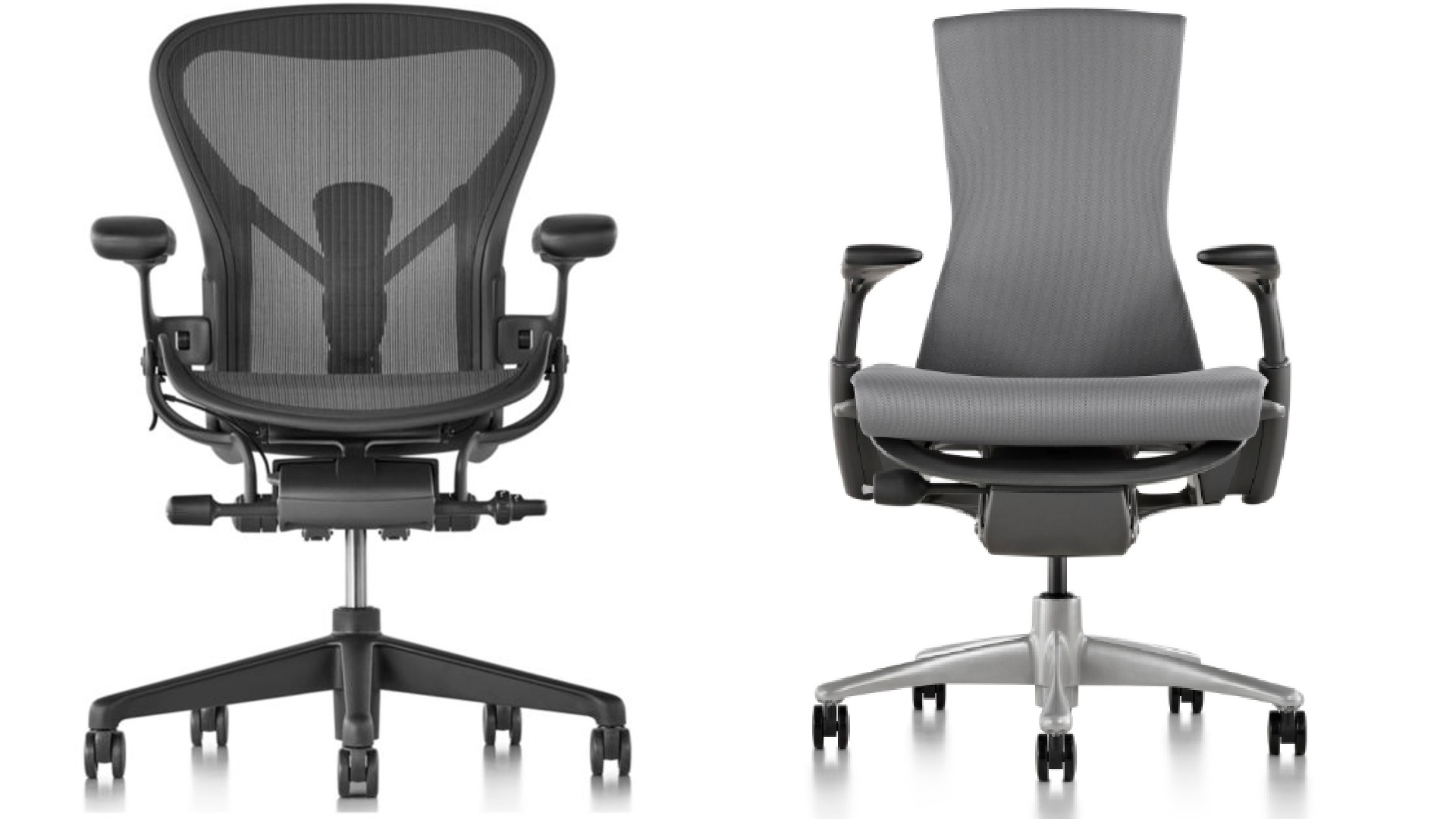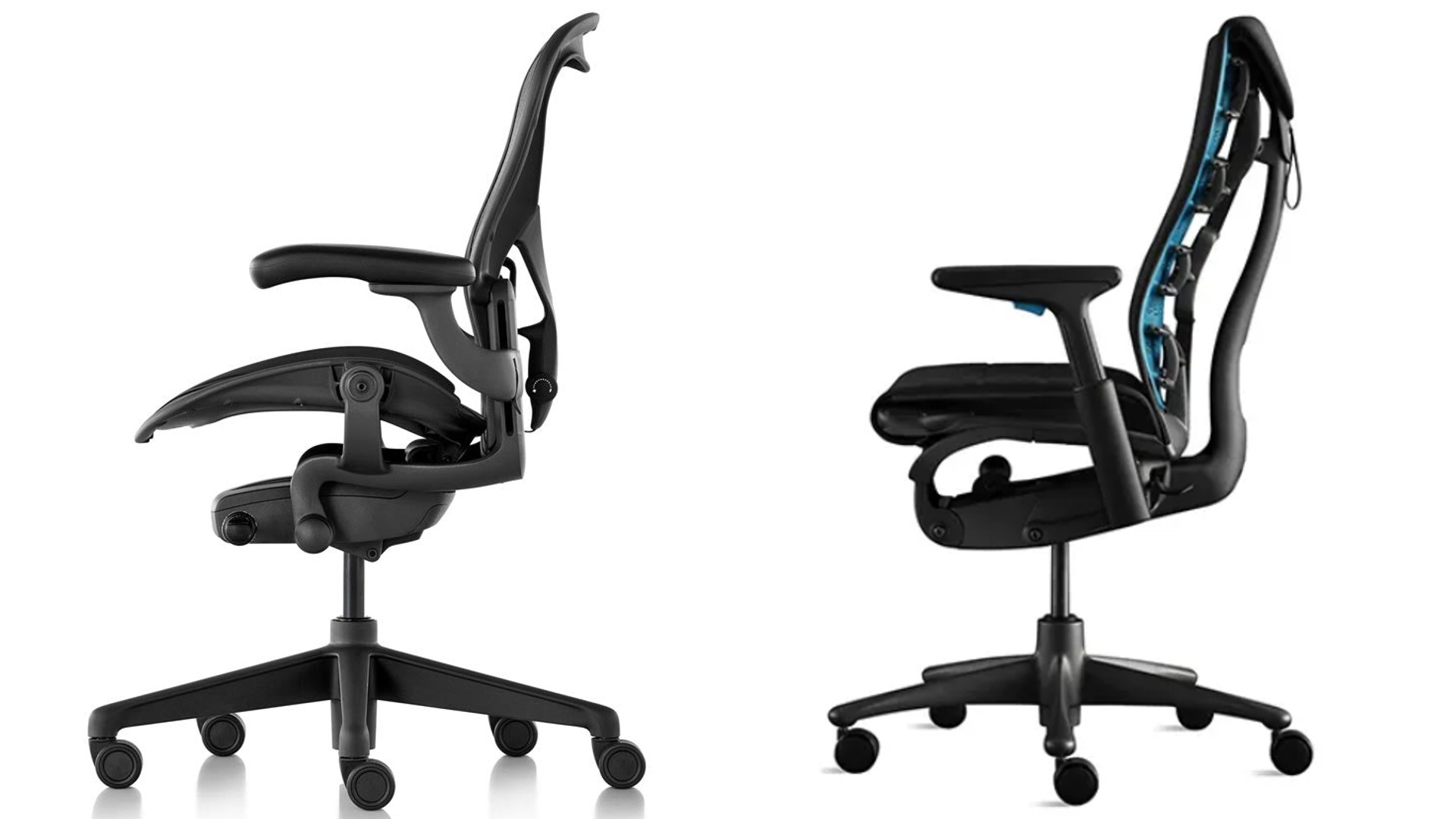Herman Miller Aeron vs Embody
We pit the entry-level Herman Miller Aeron vs Embody to discover which is the best office chair for your needs.

Herman Miller makes some of the best ergonomic office chair available, and two of its best models are the Aeron and the Embody. But which one is the best office chair for your money? Well, I've had time using and reviewing both of them for many months at a time, and it's a close call. Both are exceptional products that prioritise both style and ergonomics, and personally, I think they're two of the best chairs I've ever sat on (and there have been a few!) So in this article, I'll get into the nitty-gritty and compare these two chairs on a range of specific criteria.
In my comparison, I'll delve into the nuances, evaluating each chair's design, comfort, ergonomics and pricing to help you make an informed decision. Note that for the Aeron, I refer to the entry-model, which I tested for our Herman Miller Aeron review and which is currently around the same price as the Embody on the company's US website.
Fancy exploring more options from the brand? Then our guide to the best Herman Miller chairs is also worth taking a look at. Additionally, if posture and spinal health are your priority, our guide to the best office chairs for back pain could prove invaluable.
Build

Both the Aeron and Embody are fantastic quality, well-built chairs which arrive fully assembled. The Aeron was first launched in 1994, and was a true pioneer, helping to revolutionise the office chair industry. While it's been tweaked over the years, with a major overhaul in 2016, it's fundamentally retained the same iconic design.
The Embody, meanwhile, is a more recent creation, launching in 2009, and was slightly redesigned as a gaming chair in 2020, in collaboration with computing brand Logitech. Despite this new target market, though, it remains very popular with office workers, particularly in the creative industries.
While they have different designs, both chairs are known for their premium build quality, representing years of development and refinement. And in all honesty, you can't separate them in these terms alone.
Both are made in the USA with high-end components, both perform their functions very smoothly and reliably, and both should be expected to last for many years to come.
Verdict: Draw. Both chairs offer exceptional build quality.
Design

Each chair has a very different design. The Aeron features a bucket seat encircled by a thick frame, upholstered with a firm, flexible and breathable 8Z Pellicle mesh. As you'd expect from a chair that's part of the Museum of Modern Art's collection, it's an aesthetic classic that will look good in any office. Meanwhile, in terms of functionality, this design focuses on mesh support that aims to make you feel cradled in a specific position.
In comparison, the Embody has a larger and more padded seat, based on a four-layer system that flexes according to your weight and movements. This is made up of a base of flexible support straps, a spring suspension system, a layer of copper-fused cooling foam, and the brand's proprietary Sync fabric on top.
The back, meanwhile, features a system of pivoting, flexible, rubbery parts that aim to offer a mixture of support and flexibility across your entire spine. Overall, this design aims to provide a "floating" sensation.
As for colours, the Aeron is available in three shades of grey (Onyx, Mineral and Graphite) while the Embody is available in Black, Cyan, Amethyst or Galaxy.
Verdict: Draw. Both designs are beautifully designed, but each goes in a very different direction.
Adjustability
The Aeron and the Embody don't just have different designs, they have distinct design philosophies. For the Aeron, Herman Miller is so confident that it has created the perfect ergonomic design with the entry-level model that the amount of adjustments you can make is quite limited (with the more expensive models, you get more adjustment options, but I haven't reviewed them). Consequently, the Aeron comes in three different sizes from small to large: A, B, and C.
Herman Miller believes that these sizes cover 99 per cent of people, but it does mean that you need to pick the right size for you. If you're working part-time in a studio, then, and intend to share your chair with someone else, this could present an issue.
Assuming that's not a problem, though, the theory is that if you choose the right size, you won't need to make adjustments because the chair is so ergonomically clever, it should fit you automatically. And to quote myself a second: "The best way I can describe it is I feel like I'm in the best position that I can be in, and fully supported."
So while you can adjust the height and back tilt, on the entry-level model that's as far as adjustability goes. You can pay more add things like adjustable arms, tilt lock positions and lumbar support, but they don't come as standard.
The Embody, meanwhile, comes in one size only and is much more adjustable than the entry-level Aeron. For example, on the Embody both the height and width of the arm rests can be adjusted, whereas on the entry-level Aeron, the arm rests are fixed and can't be moved at all. Similarly, the lumbar support on the entry-level Aeron (what they 'PostureFit') is fixed, whereas the Embody comes with a knob to adjust the level of lumbar support the chair provides.
It's worth mentioning that the Embody has perhaps the best arm rests that I've ever used. They employ an ingenious design whereby the arms go up and down, but also shift left to right. And when you lower the arms they drift slightly out, and conversely when you higher them, they drift in to provide a snug support.
Other adjustments you can make on the Embody are seat height, seat depth, tilt tension and tilt limit, which determines how far the chair is allowed to recline.
Verdict: The Embody is far more adjustable than the entry-level Aeron.
Comfort & ergonomics

So in practice, which chair is most comfortable? Well, it depends what you mean by comfort. The moment I sank my behind into an Embody, I felt extra cushioning compared to the Aeron. The seat is wider, more flexible and as intended, more 'floaty'.
But comfort over time is another matter. If your chair doesn't hold you in the right position, it can lead to discomfort due to joint pain, backache and other consequences of poor posture. So that's where the ergonomics of each chair come into play. (Note: I never experienced any discomfort over the many months I tested the Embody.)
I think that both chairs offer excellent ergonomics, but which one will be right for you depends on the level of work you're willing to put in, and how flexible you need the chair to be over time. Specifically, if you're happy to spend time making fine adjustments to your chair in order to fit your body and sitting style perfectly, then the Embody will probably provide you with a better ergonomic fit once you're done.
It's so customisable that if you put the effort in, you're sure to ultimately reach the ultimate sweet spot between support and flexibility that puts your spine and body in the right alignment.
Conversely, if you generally find tweaking a chair an onerous task, and struggle to find the right combination of adjustments to suit your body, then picking the correctly sized Aeron will doubtless give you a solution you can just sit down in and get on with immediately.
Verdict: Draw. Both are very comfortable chairs. Which you find more comfortable and ergonomic will very much be a personal thing.
Price
At time of writing, the Aeron entry-level chair was $1,805/£1,338 when bought direct from Herman Miller, while the Embody is $1,830/£1,570. However, if you don't want the excellent warranty that Herman Miller provides their customers, you may want to source each chair from other retailers, which can bring the price down by a couple hundred dollars. It's also worth noting that Herman Miller offers temporary sales online too.
Verdict: Draw. It would be pedantic to say one is a winner here, as they are evenly priced.
Which should you buy?

It would be nice if we could give you a straight victor in the battle between Herman Miller Aeron vs Embody. But essentially, each chair is doing very different things. For me, this is a complete draw.
The Aeron is the one you want to go for if you like a chair to cradle you and stop you fidgeting. But the Embody is the one if you like to shift around in your seat and for the chair to cushion your movements.
The entry-level Aeron is best if you don't want to mess around making adjustments all the time. But the Embody is better if you like that flexibility in how you sit (eg, the idea of arm rests that don't move fills you with horror). It's also the obvious choice if you're going to share the seat with another person, and want them to be able to adjust it to their own needs.
Ultimately, though, we should stress that both are fantastic chairs, with stylish aesthetics, superior build quality and high levels of comfort and ergonomics. They are two of the best chairs I've ever used, so I really don't think you can go wrong with either.

Thank you for reading 5 articles this month* Join now for unlimited access
Enjoy your first month for just £1 / $1 / €1
*Read 5 free articles per month without a subscription

Join now for unlimited access
Try first month for just £1 / $1 / €1
Get the Creative Bloq Newsletter
Daily design news, reviews, how-tos and more, as picked by the editors.

Beren has worked on creative titles at Future Publishing for over 13 years. Cutting his teeth as Staff Writer on the digital art magazine ImagineFX, he moved on to edit several creative titles, and is currently the Ecommerce Editor on the most effective creative website in the world. When he's not testing and reviewing the best ergonomic office chairs, phones, laptops, TVs, monitors and various types of storage, he can be found finding and comparing the best deals on the tech that creatives value the most.
- Tom MayFreelance journalist and editor
